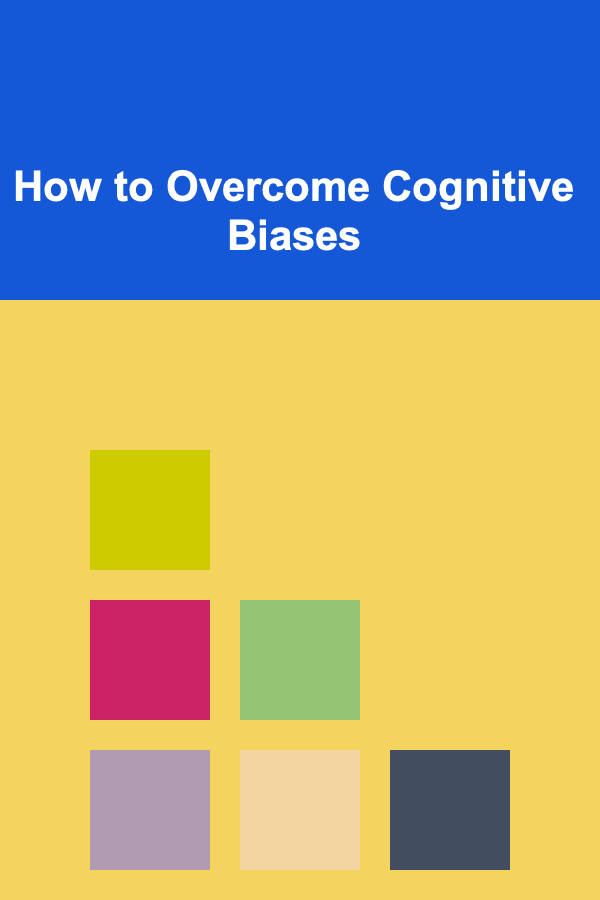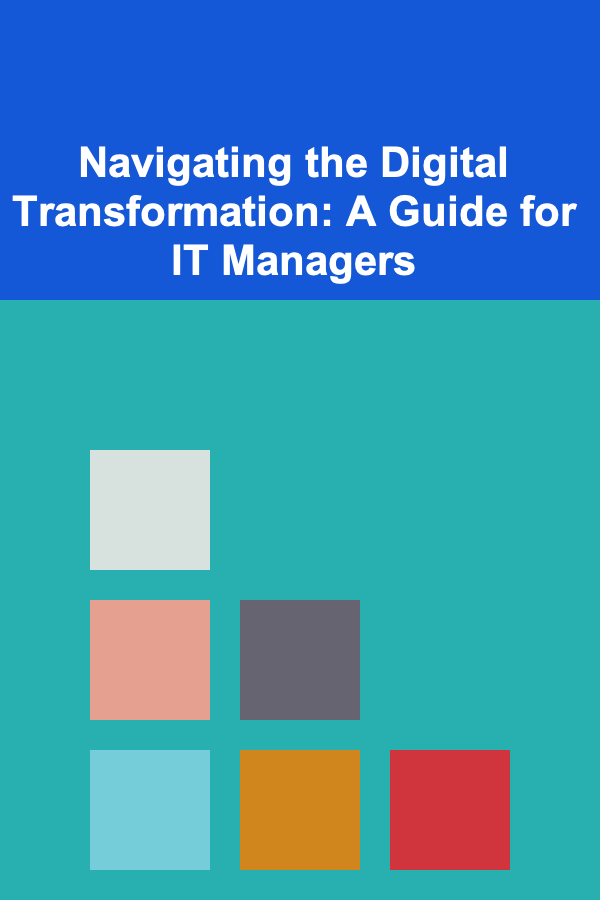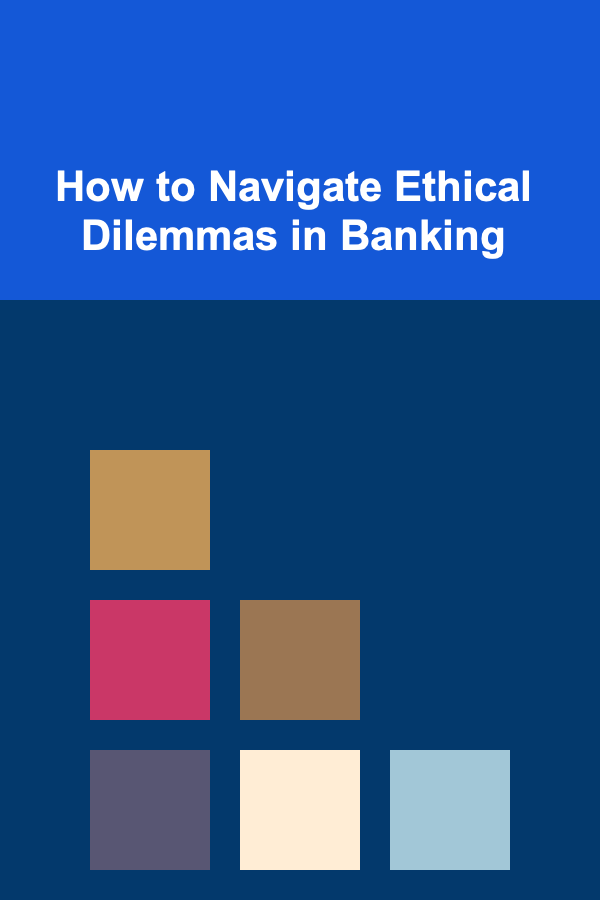
How to Overcome Cognitive Biases
ebook include PDF & Audio bundle (Micro Guide)
$12.99$7.99
Limited Time Offer! Order within the next:

Cognitive biases are the mental shortcuts or patterns of thinking that allow us to make decisions more efficiently. However, they often lead to faulty judgments, incorrect conclusions, and biased decision-making. Understanding and overcoming cognitive biases is crucial for making better decisions in both personal and professional life. In this article, we will explore the different types of cognitive biases, their impact on decision-making, and strategies to mitigate or overcome them.
What are Cognitive Biases?
Cognitive biases are systematic patterns of deviation from norm or rationality in judgment, where individuals make decisions based on subjective factors rather than objective information. These biases arise from the brain's need to simplify complex information processing. While this helps us make quick decisions, it can lead to errors in reasoning and irrational thinking.
Cognitive biases can manifest in various ways: they can influence how we perceive information, how we remember events, or how we interpret outcomes. They affect everything from everyday decisions to professional judgments and even societal trends. Some common cognitive biases include confirmation bias, anchoring bias, and availability heuristic.
The Impact of Cognitive Biases on Decision-Making
Cognitive biases can have significant consequences, particularly when it comes to making important decisions. When we rely too heavily on biases, we might:
- Make incorrect judgments: We may overlook crucial information, or focus too much on irrelevant details.
- Have skewed perceptions: Our ability to accurately interpret data and outcomes becomes compromised.
- Perpetuate harmful stereotypes: Cognitive biases often influence our attitudes toward people, leading to prejudice and discrimination.
- Make poor investments or business decisions: In a professional setting, biased decisions can result in lost opportunities or misallocation of resources.
- Miss out on better options: Cognitive biases can restrict our ability to explore all possible alternatives, limiting creativity and innovation.
Understanding the nature of these biases is the first step toward overcoming them. By becoming more mindful of how biases shape our thinking, we can make decisions that are more rational, fair, and informed.
Common Types of Cognitive Biases
Here are some of the most well-known cognitive biases that people commonly experience:
1. Confirmation Bias
Confirmation bias is the tendency to search for, interpret, or favor information that confirms our existing beliefs and ignore information that contradicts them. This bias can lead to faulty decision-making because we are less likely to challenge our own assumptions.
Example: A person who believes that eating gluten is harmful might only pay attention to articles that support this belief, while dismissing studies that show gluten is safe.
2. Anchoring Bias
Anchoring bias occurs when people rely too heavily on the first piece of information they encounter (the "anchor") when making decisions. Even if subsequent information is more accurate, the initial anchor can disproportionately influence their judgment.
Example: If a product is initially priced at $100, and later reduced to $70, people may perceive it as a good deal, even if the actual value of the product is much lower.
3. Availability Heuristic
This bias occurs when people judge the probability of an event based on how easily examples come to mind. Events that are more memorable or emotionally impactful may seem more likely, even if they are statistically rare.
Example: After hearing about a plane crash, people may overestimate the likelihood of a plane crash, despite air travel being one of the safest modes of transportation.
4. Overconfidence Bias
Overconfidence bias is the tendency for people to overestimate their own abilities or the accuracy of their knowledge. This can lead to risky decisions, as people are less likely to consider alternative perspectives or potential risks.
Example: A person may invest in the stock market without doing proper research, believing they have superior knowledge, only to suffer losses.
5. Hindsight Bias
Hindsight bias, also known as the "I-knew-it-all-along" effect, occurs when people believe, after an event has occurred, that they predicted or knew the outcome beforehand. This bias can distort our learning from past experiences and reduce our ability to make better decisions in the future.
Example: After a sports team loses a match, fans might say, "I knew they were going to lose," even though they had no way of knowing the result beforehand.
6. Attribution Bias
Attribution bias occurs when individuals attribute their own successes to internal factors (like personal ability) and their failures to external factors (like bad luck). Conversely, they may attribute others' successes to external factors and their failures to internal causes.
Example: A student who aces a test may attribute their success to their intelligence, while a peer who fails may blame the teacher for making the exam unfair.
7. Bandwagon Effect
The bandwagon effect refers to the tendency to adopt beliefs or behaviors because others are doing so. This bias is often seen in social settings where people follow the majority without critically evaluating the situation.
Example: A person may start using a popular product simply because many others are using it, without considering whether it is the best option for them.
How to Overcome Cognitive Biases
Overcoming cognitive biases requires a combination of self-awareness, critical thinking, and practical strategies. Here are some effective methods to reduce the impact of cognitive biases on decision-making:
1. Increase Awareness of Biases
The first step in overcoming cognitive biases is to recognize that they exist. By becoming aware of the biases that affect your thinking, you can take steps to counteract them. Regularly reflect on your decisions and examine whether you are influenced by any biases. Mindfulness and self-reflection can help bring unconscious biases to light.
2. Challenge Your Assumptions
To mitigate confirmation bias and other related biases, actively seek out information that contradicts your existing beliefs. Try to explore different viewpoints, and be open to changing your mind when presented with compelling evidence. Asking questions like "What is the opposing argument?" or "What would it take for me to change my opinion?" can help.
3. Gather More Information
One of the best ways to reduce biases like the availability heuristic and anchoring bias is to gather more information before making a decision. Instead of relying on the first piece of information you encounter, look for multiple sources, verify facts, and avoid jumping to conclusions based on limited data.
4. Practice Critical Thinking
Critical thinking is a key tool in overcoming cognitive biases. This involves analyzing information objectively, questioning assumptions, and examining the logic of arguments. Try to separate your emotions from the decision-making process and look at the situation from different perspectives.
Example: If you're choosing between two job offers, don't just rely on salary figures. Evaluate the full package, including work-life balance, growth opportunities, company culture, and long-term benefits.
5. Seek Diverse Perspectives
To avoid groupthink and the bandwagon effect, engage with people who have different viewpoints and experiences. By incorporating diverse perspectives into your decision-making process, you can reduce the influence of social pressures and gain a more balanced view of the situation.
Example: In a workplace setting, encourage open debates and discussions to ensure that all ideas are heard and considered before making a final decision.
6. Use Decision-Making Tools
There are several tools and frameworks that can help you make more rational decisions by providing structure to the process. For example, decision matrices, pros-and-cons lists, or cost-benefit analyses can help you evaluate options systematically and reduce the impact of biases.
7. Take Your Time
Cognitive biases thrive in environments of time pressure. If possible, take your time to make decisions, especially important ones. Allow yourself the space to think critically and evaluate all available options before reaching a conclusion.
Example: Instead of making a snap judgment about a business deal or investment, take time to research the risks and rewards, and consult with experts or colleagues.
8. Consider the Opposite
This technique involves deliberately considering the opposite of what you initially believe or want to do. By challenging your assumptions, you can better understand potential flaws in your thinking and identify alternative solutions.
Example: If you're planning a new product launch, ask yourself, "What could go wrong with this idea?" or "What would make this product fail?"
9. Limit Overconfidence
To combat overconfidence bias, set realistic expectations, and be willing to acknowledge when you don't have all the information. Make sure to gather facts and consult with experts rather than relying solely on your intuition.
Example: Before making a major decision, such as buying a house or starting a business, consult with people who have experience or expertise in the area.
10. Learn from Mistakes
One of the best ways to overcome cognitive biases is to learn from past errors. Take time to reflect on your decisions and identify instances where biases may have influenced your choices. Use these experiences as learning opportunities to improve your decision-making process in the future.
Example: After a failed business venture, examine the decisions that led to the failure and identify any biases that played a role in those decisions. Apply these lessons to your future ventures.
Conclusion
Cognitive biases are an inevitable part of human decision-making. They influence how we perceive the world, make judgments, and act in various situations. However, by becoming aware of these biases and actively working to counteract them, we can make more informed, rational, and fair decisions. Overcoming cognitive biases requires self-reflection, critical thinking, and the use of structured decision-making techniques. By adopting these practices, we can reduce the negative impact of biases and improve our decision-making process both in personal and professional contexts.
Reading More From Our Other Websites
- [Paragliding Tip 101] Paragliding Mishaps: A Beginner's Guide to On-Site Emergency Care
- [Home Storage Solution 101] How to Store Sports Equipment Compactly and Efficiently
- [Organization Tip 101] Why A Tidy Living Room Invites Relaxation
- [Screen Printing Tip 101] Essential Screen Printing Supplies Every Beginner Must Have
- [Personal Investment 101] Monetizing Deep Learning: How to Turn Your AI Models into Income
- [Home Rental Property 101] How to Manage Tenant Move-In and Move-Out Smoothly
- [Home Space Saving 101] How to Maximize Space with Storage Beds: Tips for Small Bedrooms
- [Weaving Tip 101] Understanding Basic Weave Structures: Plain, Twill, and Counter‑Weave Explained
- [Home Space Saving 101] How to Design an Inspiring Craft Room Organization System That Saves Precious Square Footage
- [Biking 101] How to Upgrade Your Bike Fork for Improved Handling and Speed

How to Discover New Treatments for Crohn's Disease
Read More
Navigating the Digital Transformation: A Guide for IT Managers
Read More
Saving Money on Fitness: Cost-Effective Gym Memberships You Need to Know About
Read More
10 Tips for Using Reverb to Create Depth in Your Mixes
Read More
How to Navigate Ethical Dilemmas in Banking
Read More
10 Common Mistakes to Avoid When Claiming Education Tax Benefits
Read MoreOther Products

How to Discover New Treatments for Crohn's Disease
Read More
Navigating the Digital Transformation: A Guide for IT Managers
Read More
Saving Money on Fitness: Cost-Effective Gym Memberships You Need to Know About
Read More
10 Tips for Using Reverb to Create Depth in Your Mixes
Read More
How to Navigate Ethical Dilemmas in Banking
Read More